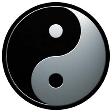
Yin-Yang Theory and Martial
Applications of Taijiquan
2006-12-R2
(Copyrighted 2006 by Don M. Tow)
The fundamental concept behind Taijiquan and the basis
for its martial applications is clearly represented by the yin-yang symbol
for Taijiquan:

In Taijiquan, one almost never
counters against an attacking force with an opposite frontal counter force
with the purpose of overpowering that attacking force with a larger counter
force.
Instead, the Taijiquan practitioner usually sidesteps
to avoid the frontal attack either completely, or partially and at the same
time uses a small side force to deflect the attacking force.
The Taijiquan practitioner basically allows the
attacker to continue in the direction of his force, and utilizes that
momentum to cause the opponent to lose his balance.
Once
the opponent senses that he may lose his balance and moves in the opposite
direction, the Taijiquan practitioner also changes direction and
counterattacks along the momentum of the opponent’s new motion.
The above illustrates at least two
aspects of the yin-yang theory.
One is the complementary aspect:
complementing the attacker’s large frontal
attack force (yang) by letting or even helping the attacker to continue to
move in that direction with a small deflective and supporting force (yin).
The other is the constantly changing aspect:
constantly sensing the opponent’s movement and
changing one’s counterattack appropriately.
This is why in the above symbol, yin and yang
together make up the whole, and yin and yang easily change into each other.
This above yin-yang concept is so
fundamental to Taijiquan that it already manifests itself in only the second
form, Wild Horse Shakes Its Mane, of the Simplified Yang Style 24 Form,
which is often the first Taijiquan set that beginners learn.
In the “Wild Horse Shakes Its Mane” form, the
Taijiquan practitioner sidesteps an attacker’s frontal attack and grabs (or
sandwiches the attacker’s attacking arm with the Taijiquan practitioner’s
two arms) and “guides” the attacker along the direction of his momentum.
This will cause the attacker to lose his
balance unless he responds by changing direction and pulls back on his
attack.
When that happens, the Taijiquan practitioner then
also changes direction and moves forward with his frontal foot and arm to
cause the opponent to lose balance in his new direction of motion.
To increase one’s sensitivity to the
opponent’s movements and intentions and therefore to be able to
counterattack more effectively, the Taijiquan practitioner needs to keep his
body, muscles, and mind relax, which is one of the fundamental principles of
Taijiquan that is universal for all styles of Taijiquan.
To facilitate the constant shifting of
directions, one needs to keep the upper body upright, which is another
fundamental principle of Taijiquan.
Because the movements in Taijiquan
are relaxed and usually soft (although there is also a mixture of hard
movements, especially in the Chen Style of Taijiquan), sometimes there is a
misunderstanding that in Taijiquan one never uses force.
This is a misinterpretation and is wrong.
Even
the famous saying “four ounces can deflect a 1,000 pounds” that is often
used to explain Taijiquan does not say “zero ounce can deflect a 1,000
pounds.”
This saying is trying to emphasize that one doesn’t
need a counterforce of over 1,000 pounds to mitigate the attacking 1,000
pound force; however, to deflect the attacking force, one still needs to
exert a small but non-zero force.
Once when I was teaching a Taijiquan
class and explaining how one should maximize one’s force by synchronizing
the movement of one’s legs, body, and hands simultaneously in the same
direction, a spectator watching said “No, no, you are not supposed to exert
any force in Taijiquan.”
He was confusing softness with zero force.
The need for a non-zero force is also clearly
shown in the Push-Hands exercise of Taijiquan.
If the opponent is attacking you with a
Ward-Off, Press, or Push movement, you need to use some force to resist that
attack, although the force doesn’t have to be large.
If you use no force and retreat too rapidly,
that will surely lead to a successful attack by your opponent.
On the other hand, if you use too large a force
to defend, you will also lose your flexibility and sensitivity allowing your
opponent to counterattack successfully.
This fundamental yin-yang principle
of Taijiquan requires the practitioner to be constantly sensing the
opponent’s movement and intention, and complementing and changing his
counterattack moves relative to the opponent’s moves.
By utilizing strategic placements of his legs,
arms, and body relative to those of the opponent, a Taijiquan practitioner
can generate significantly more leverage.
It is the application of the yin-yang
principle, together with the principle that one’s power originates from the
waist, that allows a smaller, weaker, older person to defend successfully
against a bigger, stronger, and younger opponent.
-------------------------------------------------------------------------------
Comments (or questions) from
readers are welcome.
Please specify whether you want to share your comments with only the author
of this website or with the other readers. If it is the latter, your
comments will be posted in the appropriate "Comments" page.
Please send them via an email to
[email protected].